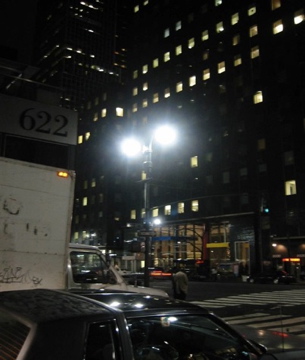It appears I gave up too quickly on the idea of re-introducing stars as night-lights in New York City. My neighbor Susan Harder, founder of Long Island's Dark Sky Society, informs me that establishing an enlightened lighting code and upgrading all the poorly designed, inefficient street lights in the metropolis would restore some measure of the heavens to the skyline.

Most street lamps in midtown, she says, emit the bulk of their glare sideways and straight up. In order to also shed sufficient light on the ground for pedestrians, these fixtures waste great quantities of wattage--drawing as much as 800 watts each, as opposed to the 150 required by properly shielded luminaires. "Any good lighting that you see in New York City," she laments, "is almost accidental."
Susan also alerted me to a new film, The City Dark, which offers "a search for night on a planet that never sleeps." Watching the trailer on-line, I recognized several of the interview subjects, including Neil deGrasse Tyson, director of New York's Hayden Planetarium.
Inside the glass house of the Planetarium, model planets and digital stars are visible any time on demand, but the night's true luminaries still make city appearances to those who know where to look. The Amateur Astronomers Association of New York (yes, there really is one) hosts frequent observing nights at various sites in Manhattan, Brooklyn and Staten Island. Amateur astronomers count among the most enthusiastic, generous individuals I know, standing ever-ready to share the views through their telescopes with just about anyone who happens by. Many professional astronomers, too, display those same positive traits, though they are less likely to drop in at a public star party: Only about 10,000 astronomers worldwide find employment in their field as teachers and researchers.
Galileo, the original amateur telescope maker (or ATM, as his latter-day confreres now call themselves), achieved major discoveries from backyards and balconies on city streets in Padua and Florence. He lived in a bygone astronomer's paradise, described by author William Manchester as A World Lit Only by Fire. But the dark nights of those times sometimes saw an original thinker consumed by fire.
